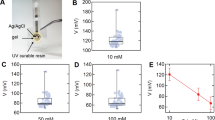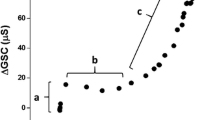Abstract
Sweat rates were continuously recorded by the resistance hygrometry technique from 4 male subjects while they either drank or were fed water at different temperatures via a stomach tube in a controlled temperature chamber at 36°C, 30% RH and also at ambient temperatures below the normal threshold of sweating. Following a drink of ice-cold water the subjects sweating in a warm room responded with an immediate depression in their sweating activity prior to any detectable change in their internal temperature. When cold water was introduced to the stomach via a tube, the subject felt the cold sensation but his sweating rate was not altered until the internal temperature decreased. However, there was no consistent response of the sweat glands to the intake of hot water. The results suggest that there are thermoreceptors in the human buccopharyngeal area. Similarly effective thermoreceptors seem to be absent in the gastric wall.
Zusammenfassung
Bei 4 jungen Männern wurde fortlaufend die Schweissbildung gemessen, die im temperaturkonstanten Raum Wasser verschiedener Temperatur tranken oder durch die Magensonde erhielten. Die Personen ruhten bei 36°C, 30% RF, und tieferen Temperaturen. Bei Personen, die in der Hitze schwitzten, folgte sofort nach dem Trinken von eiskaltem Wasser eine Senkung der Schweissrate,ehe sich die innere Körpertemperatur veränderte. Nach Einfüllen von kaltem Wasser durch die Magensonde fühlten die Personen die Kühle, doch veränderte sich die Schweissrate erst nach Senkung der Körperinnentemperatur. Die Reaktionen der Schweissdrüsen nach Gaben von heissem Wasser waren unterschiedlich. Es wird angenommen, dass beim Menschen im buccopharyngealen Bereich Thermoreceptoren vorhanden sind, nicht aber in der Magenwand.
Resume
On a mesuré de façon continue la production de sueur de 4 jeunes gens buvant ou recevant par sonde stomacale de l'eau à des températures différentes. L'atmosphère ambiante était maintenue à 36°C et à 30% d'humidité relative. La quantité de sueur dégagée diminuait immédiatement après que les personnes aient bu de l'eau glacée et cela bien avant que la température du corps ne s'abaisse. Si on leur ingurgitait la même eau par sonde stomacale, les individus en ressentaient la fraîcheur, pourtant, leur taux de sueur ne diminuait qu'avec l'abaissement de la température du corps. La réaction des glandes sudoripares après application d'eau chaude fut très diverse d'un individu à l'autre. On admet alors que, chez l'homme, on trouve des récepteurs thermiques dans la bouche ou le pharynx, mais pas dans les parois de l'estomac.
Similar content being viewed by others
References
BANERJEE, M.R., MACINTYRE, B.A. and BULLARD, R.W. (1968): Sudomotor activity as affected by the thermal status of the skin in a warm environment. Proc.Soc.exp.Biol. (N.Y.),127: 867–875.
BANERJEE, M.R., ELIZONDO, R. and BULLARD, R.W. (1969): Reflex responses of human sweat glands to different rates of skin cooling. J.appl.Physiol., 26: 787–792.
BENZINGER, T.H. (1964): The thermal homeostasis of man. Symp.Soc.exp.Biol., 18: 49–80.
BLIGH, J. (1963): The receptors concerned in the respiratory response to humidity in sheep at high ambient temperature. J. Physiol. (Lond.), 168: 747–763.
HENSEL, H. and ZOTTERMAN, Y. (1951): The response of the cold receptors to constant cooling. Acta Physiol.scand., 22: 96–105.
HOUDAS, Y., BOUTELIER, C. and COLIN, J. (1965): Influence d'une ingestion d'eau sur le debit sudoral. J.Physiol. (Paris), 57: 629–630.
KUNO, Y. (1956): Human Perspiration. Thomas, Springfield, p. 265.
LADELL, W.S.S. (1955): The effects of water and salt intake upon the performance of men working in hot and humid environments. J.Physiol. (Lond.), 127: 11–46, 1955.
LECHNER, P.L. and HERTIG, B.A. (1969): Effect of water intake on sweat rate. (Abstract) Fed.Proc., 28: 528.
LEE, D.H.K. and MULDER, A.G. (1935): Some immediate effects of reduced cooling powers upon the water balance and related effects in the human subject. J.Physiol. (Lond.), 84: 410–432.
MILSUM, J.H. (1966): Biological Control Systems Analysis. McGraw-Hill, New York, p. 80.
NAKAYAMA, T. (1966): Synopsis of neurophysiological studies of thermoregulation on integration of thermal afferents. Fed.Proc., 25: 1286–1288.
NICOLAIDIS, S. (1964): Etude d'une reponse de sudation après ingestion d'eau chez le sujet déshydrate. C.R.Acad.Sci. (Paris), 259: 4370–4372.
RUCH, T.C. and PATTON, H.D. (1966): Physiology and Biophysics. Saunders, Philadelphia, p. 309.
SENAY, L.C. Jr. and CHRISTENSEN, M.L. (1965): Cardiovascular and sweating responses to water ingestion during dehydration. J. appl.Physiol., 20: 975–979.
SHIBOLET, S. and GORDON, R. (1970): Effect of drinking on sweat rate. (Abstract) Fed.Proc., 29: 794.
STRÖM, G. (1960): Central nervous regulation of body temperature. In: Neurophysiology, Handbook of Physiology. Amer. Physiol.Soc., Washington, D.C., Sec. 1, Vol. II, 1183.
VAN BEAUMONT, W., BULLARD, R.W. and BANERJEE, M.R. (1966): Observations on human sweating by resistance hygrometry. Dermatol.Digest, 5: 75–87.
Author information
Authors and Affiliations
Additional information
This study was supported by the Air Force Office of Scientific Research, Office of Aerospace Research, US Air Force, (Contract F44620-68-C-0014) and by the US Army Medical Research and Development Command (17-68-C-8066). A major portion of this paper was presented during the Fifth International Biometeorological Congress, Montreux, Switzerland, 31 August to 6 September 1969.
Rights and permissions
About this article
Cite this article
Banerjee, M.R. Transient changes in sweating activity of man following ingestion of walter at different temperatures. Int J Biometeorol 14, 381–390 (1970). https://doi.org/10.1007/BF01462915
Received:
Issue Date:
DOI: https://doi.org/10.1007/BF01462915




